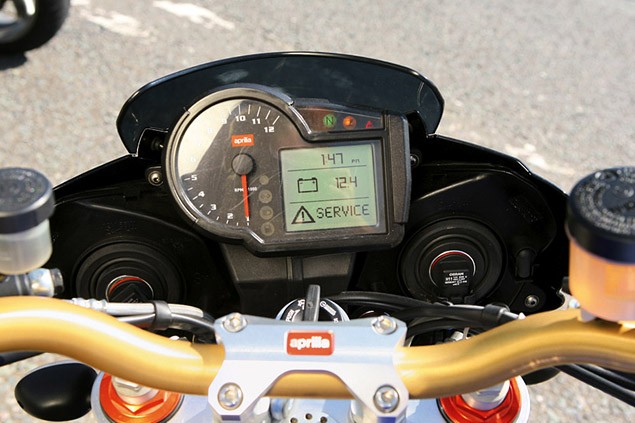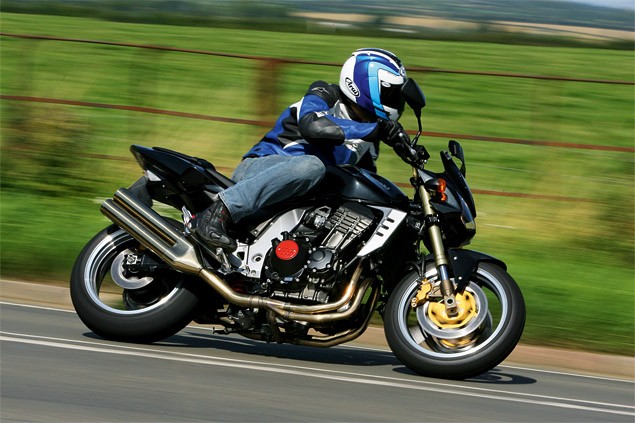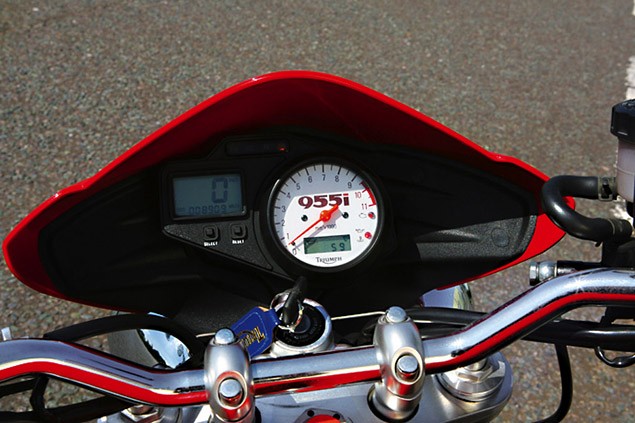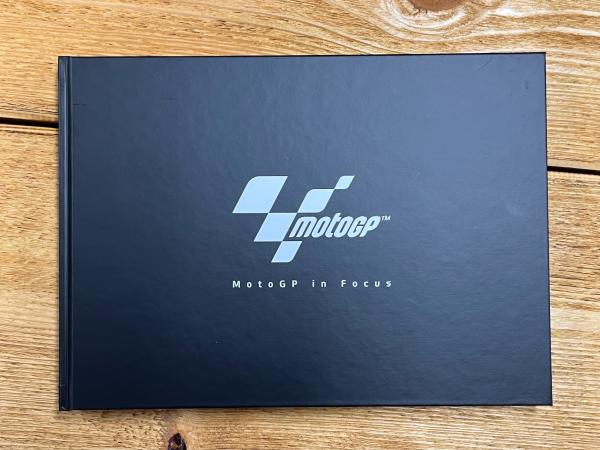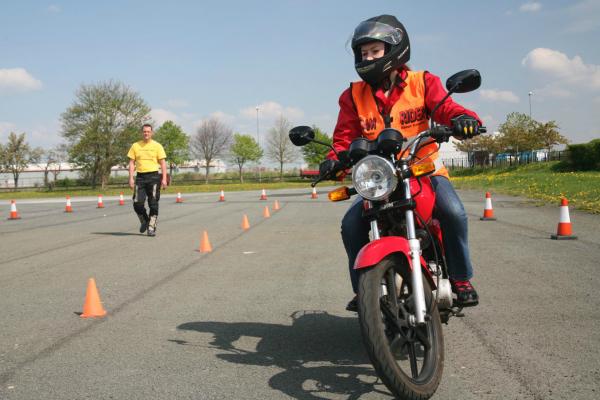You would be forgiven for thinking the current craze for stripped down street bikes is a recent phenomenon. Pop into your local dealer tomorrow and you will have your pick of just about any engine configuration from every manufacturer when it comes to a naked bike with big flat bars. The choice is downright confusing to say the least, baffling to be more accurate.
But the truth of the matter is that street bikes have been around for ages, it’s just in the last few years that the concept has gained a degree of momentum. Which is great news for the secondhand buyer as it means that the used market is starting to fill up with brilliant examples of early street bikes. And best of all the secondhand choice is no less varied than that of the new machinery.
We looked through the dealer ads to find our pick of the bunch with a price tag around the £4,500 area and then added an extra constraint to spice things up; none were to have the same engine configuration.
With this in mind we uncovered a 2004 Speed Triple with a screen price of £4,300, a truly classic street bike and the model before Triumph went all ‘funky’ with the looks. A 2004 Kawasaki Z1000 for £4,300, arguably the first of the Japanese inline four street bikes that brought styling as well as versatility to the table and finally a 2006 Aprilia Tuono. Although this bike was priced at a touch under £5,000, when buying a secondhand Tuono it is far better to pay a bit more and get this model as it is the first of the updated generation of Tuono and is a superior bike to the original version.
So, with our three bikes selected we headed onto the twisty and undulating back roads on the hottest day of the year to sample some naked tomfoolery.
��
2006 Aprilia Tuono
Aprilia Tuono
The Italian rapscallion with a wild side
Click to read: Aprilia Tuono owners reviews
You will either love or hate a Tuono, there isn’t really any middle ground when it comes to this stripped down ‘fighter. From the moment you start your ride to when you finally turn the key to the off position several miles later, you have the constant feeling that you are riding on a knife-edge. Which, to many, is the main appeal of this street bike, it’s true to the very essence and philosophy of the concept and simply refuses to be watered down in any way, shape, or form. Conversely to others this is a perfect reason to avoid ownership.
Swapping from the low and wide Jap to the tall Italian, at first everything about the Tuono feels alien. The bars are wide, the bike feels long and the ground appears to be miles away. For shorter riders the Tuono can be a struggle due to its physical size and seat height, but this sheer presence is what sets the Aprilia aside. You don’t ride around meekly on a Tuono, you intimidate the traffic and force your way through.
Everything on the bike screams aggression. From the slightly suspect Eastern European football team kit paint scheme to the almost half-finished look and insectoid front end it all has a feeling of attitude, something that is reflected in the engine and handling.
The V-twin motor is exactly the same as used in the firm’s RSV-R sportsbike. No retuning, no different cams, just pure, raw sportsbike performance in a streetfighter. Let the grabby clutch out and the Tuono takes off and rockets forward with disconcerting haste. Through town, or in areas where a little delicacy is required with the right hand, this eagerness to impress can get a bit annoying as it’s fairly hard to control such a brutal power delivery at low speeds, especially when combined with the grabby clutch and piss-poor steering lock. But get the Tuono on the open roads and the engine is in its element.
If you like to go nuts on twisty roads on your street bikes then look no further than the Aprilia. With a genuine 120bhp on tap the free-revving V-twin motor never fails to impress, easily lifting the front wheel over rises in the road in any of the first three gears and driving to the redline with a serious hunger. You simply can’t help but giggle and succumb to the urges to feed it more power and up the pace. Something the chassis is more than happy to deal with.
Like its engine the chassis is pure RSV-R, just with a set of flat bars fitted above the top yoke rather than the low-slung clip-ons. Although the more upright riding position gives the bike a tendency to flop into corners, once lent over the quality suspension easily dispatches any undulations and gives you a sense that no matter how hard you went around that bend, the bike could probably have gone faster if required. Which is another thing that sets the Tuono aside from the other bikes in this test, you could happily take it on a trackday and hold your end up in any of the three groups. A fast rider on a Tuono will easily keep up with the race rep brigade, and probably better a few, especially on the brakes.
It’s staggering how hard you can slam the anchors on with a Tuono. Braced against the chunky bars you can haul up the Aprilia in no time at all thanks to the ferocity of the Brembos. If you like your bikes to be flighty, raw and aggressive then the Tuono ticks all the right boxes. It isn’t much fun anywhere where it isn’t allowed to stretch its legs and has a serious phobia for confined spaces. But get it out into the open road and it comes alive, delivering a rewarding and thrilling ride. Is this enough to justify ownership? Yes, but only if you are the kind of rider that wants this. If you are looking for a nice, relaxed bike to see you through a dull commute the Tuono will probably drive you to distraction.
Aprilia Tuono Essential Info
Prices
Prices: From £4,795 (2006, 12,000 miles) to £9,999 (2009, 0 miles).
The latest model of the Tuono is still in Aprilia’s line-up, so can be had brand new for ten large. However, there are plenty of three-year-old secondhand bikes for half that price, probably due to the fact that this really is a stripped down superbike. Many riders find the Tuono a bit much and often seek something a little more manageable. The net result is plenty of bikes on the market without huge mileages on the clocks.
Instant upgrades
- Exhaust: The Tuono makes such a wonderful sound with a set of open pipes it’d almost be a crime not to make the most of it. Aprilia have an official option that’s made by Akrapovic. It’s road legal with removable baffles for when you really want to get noticed (www.accessories.aprilia.com). At £869.56 they’re not cheap, though.
- Power Commander: Another bike that could do with some time spent on its fuelling. As standard it’s pretty jerky, and adding cans can often make’s it even worse. A Power Commander and some time on a dyno works wonders. £298.33 (www.dynojet.co.uk).
- Screen: Aprilia offer an official screen for £144.99. It’s hardly likely to turn the Tuono into an u¨ber tourer, but it’s definitely a worthwhile addition if you’re likely to use the bike for any kind of distance work.
- Tail pack: Underseat storage on the Aprilia isn’t great. Ventura can help with their Sports Pack. £187.39 (www.ventura-bike.co.uk)
Parts costs
The Tuono has a very tall sidestand that makes the bike sit too upright and very close to the bike’s balance point. Because of this 0mph spills are common. A new brake lever costs £50.60 while an indicator is a fairly reasonable £12.12. Should it all go very badly wrong, start preparing for a £287.50 bill if the radiator gets holed.
Common faults
It’s Italian so the electrical system is the weak spot on the Tuono. Owners have had starting issues and fuses blowing seemingly without provocation. The well-known misting clocks problem can affect the Tuono, although later models seem not to suffer with it as much as the earlier ones. As with the Mille, the rear brake can be worse than useless unless it’s serviced regularly.
Even with these faults, there doesn’t seem to be any major mechanical problems with the Tuono, but beware - some owners have described life with the Tuono as a frustrating experience – often down to something as simple as down to a wire shorting out or Aprilia not being able to supply spare parts quickly enough.
2004 Kawasaki Z1000
Kawasaki Z1000
The first naked head-turner from Japan
Click to read: Kawasaki Z1000 owners reviews
When the Z1000 emerged onto the scene in 2003 it looked like nothing else. This was a bike designed to look good and, along with the new ZX-6R, drag Kawasaki out of some dark years. It was the face of new Kawasaki, a company that now had bold ideas and a new impetus.
Looking at it today the Z1000 is still cool, in a quirky Manga kind of way. If you ignore the slightly dubious aftermarket screen on this bike, the Z’s sharp and distinctive lines remain and the twin ‘pea shooter’ pipes with their gold anodised finish have a certain charm. Six years is a long time when it comes to bike design, but the Z has stood the test well as it manages to be different, but not plasticky and outlandish.
But despite this look, when you sit on it the Z1000 is oddly familiar. The wide tank splays your legs open, the rubber-padded pegs are set at a comfortable and relaxed height and the bars are a natural distance rather than a stretch away. It’s not an aggressive, hunched up riding position as with some street bikes, but an open-armed cruise with your body well forward on the bike. Then you push the starter and you realise why it feels familiar.
As soon as the starter motor whirrs memories of ZX-9Rs fill your head. The Z has the same wide tank and relaxed peg position as the last of the ZX-9Rs and the engine sounds the same, mainly because it basically is. Kawasaki gave the ZX-9R motor a 55cc increase in capacity and replaced the carbs with fuel injection for the Z1000. So you would expect it to have some grunt, and it does, but only if you go searching for it.
This is the Z1000s biggest bugbear. With a big-bore inline four engine you would anticipate the Z would explode off the bottom end and provide strong drive, unfortunately it simply doesn’t deliver this. Compared to the Tuono, which is almost too willing to stomp forward and the punchy Triple, the Z feels flat and lethargic until it gets into its stride and the real power doesn’t come in until the completely unreadable rev counter is building liquid crystal blocks towards the 5-6,000 rpm area.
According to owners a lot of this lack of grunt is to do with the cans, which look great but are horribly restrictive, and swapping them for free-breathing ones instantly releases 6-8bhp as well as a whole heap of grunt.
But once spinning the Z is fast and the engine retains the smooth drive that is associated with a big capacity Japanese inline four. In a typical clinical fashion it all seems to work with minimal fuss and with none of the quirks of the other two, and although there is a slight vibration through the bars this is easily put down as character. What is less easy to forgive, however, is the handling.
From its launch in 2003 question marks were raised over the Z1000’s front end. Push the Z hard through the bends and it doesn’t have the same secure feeling as the Tuono or even the Speed Triple as the feedback from the front tyre is vague, something not helped by the soft suspension. Although the Z has fully adjustable suspension the standard settings are soft and spongy, and even adding compression seems to do little to sort this. At lower speeds it’s not a bother, and through town the Z’s excellent steering lock, light clutch and low seat height make it easily the best here in town.
The Z1000 feels like a bog-stock Japanese bike that does everything it should all neatly packaged and spiced up with funky good looks. But then sometimes just looking good isn’t enough and, in the case of the Z, the standard bike is the epitome of style over substance. The potential is there, but it needs unlocking and character will only come with personalisation. Think of owning one as work in progress.
Kawasaki Z1000 Essential Info
Prices
Prices: From £3,000 (2004, 21,000 miles) to £5,300 (2007, 4,000 miles).
The original Z1000 looks brilliant with its standard dual-sided pipes and many people were drawn towards its badass image. While being surpassed in the street bike stakes now, it’s still a popular choice. With the first model released six years ago, it’s modern enough to offer plenty of thrills, and with prices starting at just £3000 it’s not too hard to see why it makes a tempting prospect for anyone wanting an upright, wide-barred sportsbike. A mint two-year old machine can be had for the relatively low price of £5000.
Instant upgrades
- Suspension: The suspension has come in for some stick on the Z as some people feel it doesn’t give them the ride quality they want. MCT (www.mctsuspension.com) can set up the standard equipment to suit individual needs, which is much cheaper than buying new suspenders all round.
- Tyres: With the suspension sorted, it’s time to chuck some sticky tyres such as Dunlop Sportmax Qualifier IIs on the Z. At around £210 (www.dunlopmotorcycle.co.uk) they should make the most of its newly found cornering ability.
- Exhaust: Although the standard pipes look fantastic, the engine could do with liberating a bit to make the most out of it. A pair of Arrow cans for £485.68 (www.bandcexpress.co.uk) would do the trick.
- Power Commander: To get the fuelling just right for the new cans, a Power Commander is vital. At £298.33 (www.dynojet.co.uk), it’s an investment worth making to get the most out of the engine’s hidden potential.
Parts costs
If you own a Z1000 the first thing you need to buy is a set of crash bungs. Why? A new radiator costs a wallet shattering £477.01. A replacement front brake lever is a costly £35.12 while an indicator costs £40.54. The Z is a bike you can’t afford to crash!
Common faults
The Z1000’s motor is based on the ZX-9R, so you’d expect it to be pretty reliable as the ZX-9R was in production for nearly 10 years. And in that respect you won’t be disappointed. The only complaint from owners seems to be the quality of the paint on the bike, which is something that seems to be affecting more and more modern Japanese bikes.
With the Zed, owners find it difficult to match the colours when they want to get it re-painted. Other than that, as long as a previous owner hasn’t horribly abused the bike and the service schedule is adhered to, it should run and run without any major problems. Don’t fear high mileage, but only if it’s a total bargain. Z1000s are plentiful though, so take the time to find a minter
2004 Triumph Speed Triple
Triumph Speed Triple
The original streetbike that has mellowed with age
Click to read: Triumph Speed Triple owners reviews
When I rolled the Speed Triple out of the back of the van it was met with some amusement and a degree of snobbery by other riders on this test. Which, to be fair, isn’t that surprising. Standing next to the sharp looking Tuono and oddly cool Z1000 the Triumph looks decidedly old hat, almost a relic from another age.
Having started the whole street bike ball rolling with its original Speed Triple back in 1994, Triumph has been keen to retain the look of its naked bike. This is all very well and good, the twin headlight stare of the Triple is certainly an iconic image and one that is instantly Triumph, but it does give the bike a dated look. Or does it? When does a bike’s styling morph from being dated to being a classic look?
Which is partly the reason why this 2004 Speed Triple still commands a relatively high asking price. Triumphs hold their value well and don’t depreciate, or date, as badly as bikes like the Tuono or Z1000. Plenty of owners opt for the more retro 2004 look than the stubbier, (and far less practical when it comes to pillions), 2005 model.
But the odd thing about the Speed Triple is how it slowly grows on you. Initially, and this is certainly an impression formed by the Triumph’s look, the Speed Triple feels big, soft and decidedly rounded around the edges, especially compared to the aggressive Tuono. The seat is squidgy, the bars appear to be made of fairly thin, cheap looking metal rather than chunky motocross style ones on the Aprilia and the odd flyscreen and clocks seem in a different postcode to the rest of the bike. It all has the impression of age, right down to the playschool switchgear and cheap key. Then you get going.
Once moving the Triumph starts to make you smile. Not because it is going bonkers like the Aprilia and getting you into all sorts of trouble, but because it’s gently guiding you through the ride and working with you to make it a pleasant experience. Get over the horrific clunk and ancient feel of the gearbox and simply enjoy the character of the bike and its lovely triple cylinder motor.
The 2004 bike is the model before the Speed Triple went to 1050cc and uses the older 955i engine from the Daytona. Although it lacks the initial drive that the bigger motor enjoys, it’s still far gruntier than the Z1000 and infinitely more controllable than the Tuono at low rpm, yet still has a decent kick when the revs rise. It’s an engine that although unlikely to set the world on fire will leave you pleasantly impressed, rather than frothing at the mouth with fear or excitement.
And it’s the same story with the handling. The Triumph’s suspension is soft and forgiving, yet somehow still manages to remain taut enough to allow the bike to be hustled through the corners. It’s nowhere near as precise as the Aprilia, and would be out of its depth on track, but it’s a far more balanced road package that seems to work with minimal hassle or aggravation.
But there are still parts of the Triumph that feel old. The brakes are very on/off and when they do work aren’t all that powerful, especially when compared to the radial-shod rivals and, although this bike was in excellent condition, it’s not hard to find Triumphs that are showing their age when it comes to build quality.
The Speed Triple is a lovely rounded bike that doesn’t really have any outstanding features, but gets on with the job in hand and gets on with it very well. It’s a bike that grows on you and soon becomes a firm friend, rather than try and intimidate like the Tuono or frustrate like the Kawasaki. Oddly enough, despite the fact it’s hard to pinpoint any of its real charms, the Triumph seems to be the bike with the most soul and character out of these three.
Triumph Speed Triple Essential Info
Prices
From £2,600 (2001, 30,000 miles) to £4,995 (2004, 7,000 miles).
A bit of a cult bike, the Speed Triple has a strong following in the UK. And it’s hardly a surprise considering it’s such good fun. With interest still high in these bikes prices are still keen – even eight-year-old machines are going for more than £3000 in most cases; if the price drops much below this it’s probably got quite a few miles under its wheels. As engine capacity increased to 1050cc in 2005, however, there are quite a few 955is on the market so haggle hard and there could be a bargain to be had..
Instant upgrades
- Exhaust: The Speed Triple has an antisocial side just waiting to be unleashed, so sticking a Blue Flame can on should give the bike the roar it needs. From £280 (www.blueflameperformance.com).
- Undertray: Tidy the back end up with an undertray. Flush fit indicators and a tiny numberplate bracket fit this style of bike brilliantly and get rid of the ugly factory fit item. £89.95 (www.triumph-online.co.uk)
- Protection: With the bike having a bit of a reputation as a hooligan machine, it’s probably going to get dropped at one point or another. R&G make a range of crash bungs to help protect the fragile plastics. From £21.27 (www.rg-racing.com)
- Sprockets: Make wheelies even easier by dropping a tooth or two off the front sprocket. Renthal do a range of sprockets from £11.99 (www.bandcexpress.co.uk).
Parts costs
As the bike is made in the UK you might expect the parts to be cheap, after all they hardly have to travel. Wrong. The front brake lever is a whopping £38.78, the indicator a steep £32.80 and the radiator a quite shocking £412.84. A lot of Triumph parts are common between models, check this route out and buy secondhand.
Common faults
There doesn’t seem to be many faults reported with the 955i Speed Triple, and it appears to have a good reliability record. There was a factory recall on the fuel connectors as there was a possibility they could break off, but other than that the issues that arise are generally one-offs.
Many owners recommend getting the latest fuel maps available, as the original didn’t have the best throttle response at low rpm. Other problems weren’t widespread and could just be due to a single part failure or owner neglect, such as the bike burning oil or regularly needing the head bearings tightened. The 955i didn’t suffer the brake problems that the 1050 struggled with at the beginning of its life, so they shouldn’t give 955i owners any reliability issues.
Street Assassins - Verdict
VERDICT
The Speed Triple was the surprise package of this test. Before riding the bikes we all assumed the Aprilia would decimate the other two thanks to its powerful engine, sportsbike chassis and cool looks. But it wasn’t anything like that clear cut. Each bike brought with it its own unique charm to the table, making splitting them extremely hard.
Our least favourite was the Kawasaki Z1000, but having said that it was the one we would all have chosen if we were forced to deal with a city commute. The look is still quite funky and easily improved upon thanks to the vast array of aftermarket kit available for the Z, but the motor’s lack of any real grunt and the slightly vague handling meant that the weekend blasts wouldn’t have been as much fun as they deserved to be.
For a weekend of madness, the Tuono was streets ahead of the other two. This is a bike that is little more than a sportsbike with flat bars and it responds as such. If you want razor sharp handling and a corking motor that delivers its huge power with a real sense of excitement the Tuono is the ultimate weekend toy.
Yes it has irritations, such as the terrible steering lock and the fact it’s a bit all or nothing, but if you are trying a streetbike having spent most of your time on sportsbikes, the Tuono will not disappoint as it provides all the thrills and power of a sportsbike, but in a street bike guise.
Which leaves the Triumph, a bike that has matured with age into the easiest bike of these three to live with. It’s comfortable and could happily cover a commute, despite the lazy turning circle. But more than that it’s fun and involving to ride, without being tiresome. At the start of the day none of us would have ever thought the Speed Triple would have made such an impact or been so enjoyable to ride, but as wise men often say, looks can be deceiving.
Which bike offers the best value for your pound? At the end of the day the day when it comes to the quality of components, performance and handling the Tuono is easily the best value for money, but if you are looking for sheer riding enjoyment the Triumph has something money can’t buy. A massive stack of character.
Specifications
Aprilia Tuono
Price: £4,800
Top speed: 155mph Engine: 998cc, liquid-cooled, 8-valve V-twin
Bore & stroke: 97mm x 67.5mm Compression ratio: 11.8:1
Power: 118bhp at 9,500rpm Torque: 78 lb/ft at 8,500rpm
Front suspension: 43mm inverted Showa forks Adjustment: Preload, compression and rebound
Rear suspension: Monoshock Adjustment: Preload, compression and rebound
Front brakes: Four-piston calipers, 320mm discs
Rear brake: Twin-piston caliper, 220mm disc
Dry weight: 185kg (408lbs) Seat height: 810mm Fuel capacity: 18 litres
Colour options: Grey/black, blue/white, red/white
Kawasaki Z1000
Price: £4,300
Top speed: 152mph Engine: 953cc, 16-valve, liquid-cooled inline four
Bore & stroke: 77.2mm x 50.9mm Compression ratio: 11.2:1
Power: 125bhp at 10,000rpm Torque: 70 lb/ft at 8,200rpm
Front suspension: 41mm inverted forks Adjustment: Preload, compression and rebound
Rear suspension: Monoshock Adjustment: Preload, compression and rebound
Front brakes: Four-piston calipers, 320mm discs
Rear brake: Single-piston caliper, 220mm disc
Dry weight: 198kg (436lbs) Seat height: 820mm Fuel capacity: 18 litres
Colour options: Black, red, green, orange
Triumph Speed Triple
Price: £4,300
Top speed: 150mph Engine: 955cc, 12-valve, liquid-cooled triple
Bore & stroke: 79mm x 65mm Compression ratio: 12:1
Power: 120bhp at 9,100rpm Torque: 78 ft/lb at 5,100rpm
Front suspension: 43mm RWU forks Adjustment: Preload, compression and rebound
Rear suspension: Monoshock Adjustment: Preload, compression and rebound
Front brakes: Four-piston calipers, 320mm discs,
Rear brake: Twin-piston caliper, 220mm disc
Dry weight: 187kg (412lbs) Seat height: 815mm Fuel capacity: 21 litres
Colour options: Black, red, silver, green


